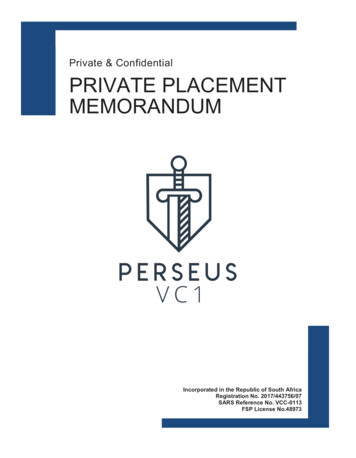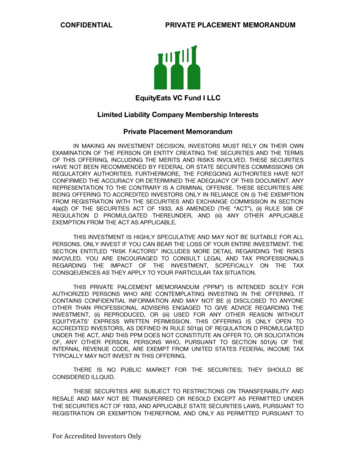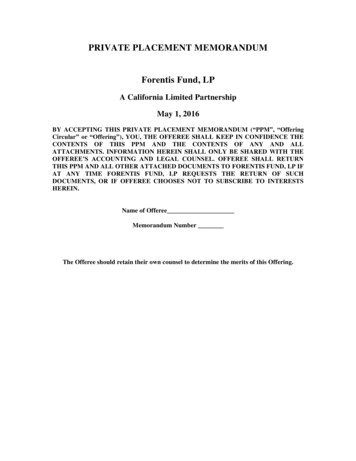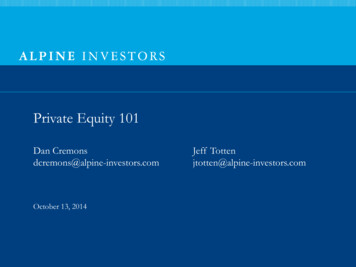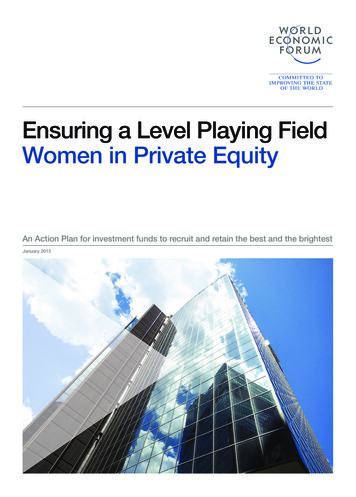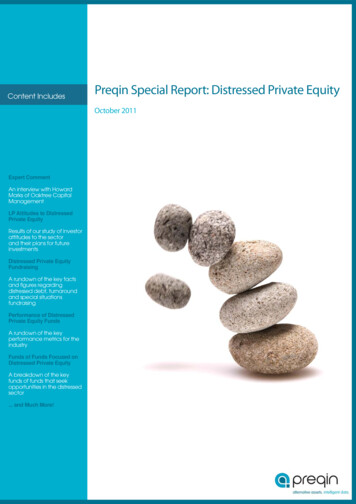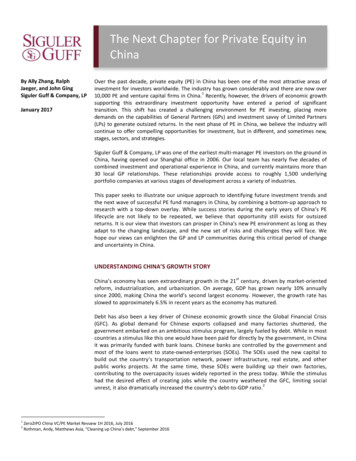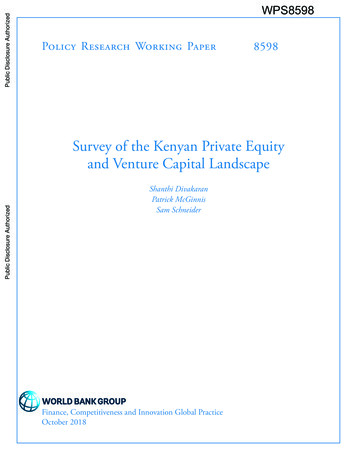
Transcription
Public Disclosure AuthorizedPublic Disclosure AuthorizedPolicy Research Working Paper8598Survey of the Kenyan Private Equityand Venture Capital LandscapeShanthi DivakaranPatrick McGinnisSam SchneiderPublic Disclosure AuthorizedPublic Disclosure AuthorizedWPS8598Finance, Competitiveness and Innovation Global PracticeOctober 2018
Policy Research Working Paper 8598AbstractThis paper discusses the landscape for private equity andventure capital financing in Kenya. It provides an overviewof the private equity and venture capital market in the country, describing key players, including funds, fund managers,investors, and public sector entities. The paper provides ananalysis of key market drivers and impediments, as wellas legal/regulatory/taxation drivers and impediments thataffect Kenya’s private equity and venture capital industry.This paper is a product of the Finance, Competitiveness and Innovation Global Practice. It is part of a larger effort by theWorld Bank to provide open access to its research and make a contribution to development policy discussions around theworld. Policy Research Working Papers are also posted on the Web at http://www.worldbank.org/research. The authorsmay be contacted at sdivakaran@worldbank.org.The Policy Research Working Paper Series disseminates the findings of work in progress to encourage the exchange of ideas about developmentissues. An objective of the series is to get the findings out quickly, even if the presentations are less than fully polished. The papers carry thenames of the authors and should be cited accordingly. The findings, interpretations, and conclusions expressed in this paper are entirely thoseof the authors. They do not necessarily represent the views of the International Bank for Reconstruction and Development/World Bank andits affiliated organizations, or those of the Executive Directors of the World Bank or the governments they represent.Produced by the Research Support Team
Survey of theKenyan Private Equity andVenture Capital Landscape1Authors: Shanthi Divakaran, Patrick McGinnis, SamSchneiderJEL: G24, G23Keywords: Private Equity, Venture Capital, Kenya, IndustryAssessment, Legal Analysis1This World Bank report was completed in December 2017.
AcknowledgementsThis report was prepared by a team consisting of Shanthi Divakaran (Team Leader and Senior FinancialSector Specialist, World Bank), Patrick McGinnis (Expert Consultant), Sam Schneider (Consultant),Anjarwalla & Khanna (law firm, Kenya) and Viva Africa Consulting LLP (tax advisory firm, Kenya). TaniaPriscilla Begazo Gomez (Senior Economist, World Bank) provided valuable input. Elikia Nenkamprovided additional research assistance. The report is a product of World Bank dialogue with the KenyanNational Treasury on broader financial sector issues and access to finance led by Mehnaz Safavian (LeadFinancial Sector Specialist); and with the Ministry of Industry, Trade and Cooperatives on private sectordevelopment issues led by Maria Paulina Mogollon (Senior Sector Economist). This report was partiallyfunded by the Kenya Investment Climate Program-II, which was generously supported by DFID and theNetherlands. The team is thankful to WBG Peer Reviewers Kevin Njiraini (Chief Investment Officer, IFC)and Dipta Shah (Investment Officer, IFC) for their valuable comments and input. Toshiaki Ono, FinancialSector Specialist, GST3, also provided very helpful comments on the report. The team is also thankful toall internal and external colleagues who were interviewed and provided input as part of this report. Aninterview list is provided in the annex.2
I.Recent Evolution of the Private Equity and Venture Capital IndustryA.Industry Overview: Kenya in ContextLess than a decade ago, the fledgling commercial private equity industry2 in Africa was largely confined toand based out of Southern Africa. From 2008 to 2010, nearly 60 percent of investment in Sub-SaharanAfrica was destined for South Africa, with regional hubs like Nigeria and Kenya trailing far behind in termsof both market share and mind share. Then, aided by continent-wide resilience in the aftermath of the 2008global financial crisis, the region’s growth story attracted an influx of private equity investors to Africa.These new entrants looked beyond the increasingly crowded South African market to explore other subregions and countries on the continent (Figure 1).Figure 1: Distribution of Sub-Saharan Africa PE Investment by Value% Total Investment: 2008-10% Total Investment: 2013-15Other, 20%South Africa28%Other37%Kenya, 8%South Africa,57%Nigeria, 15%Kenya16%Nigeria19%Source: EMPEAWithin this context, East Africa, and particularly Kenya, has become an increasingly important destinationfor private equity investors. Beyond offering relative regulatory stability, Kenya has long been known forits private sector-led economy, and for the sophistication of the business environment, both in an absolutesense, but particularly relative to the other economies of East Africa. In addition, Kenya boasts a strongentrepreneurial class and benefits from a good supply of human capital, both local and international. Thus,when private equity interest migrated from South Africa into the rest of the continent, Kenya captured adisproportionate share of the activity, both in terms of deal flow and funds. Although it is just the thirdlargest country in East Africa by population, and the seventh largest economy in Africa by nominal GDP,Kenya’s standing in the alternative investment industry in Africa is notable. The country now ranks thirdbehind South Africa and Nigeria in terms of private equity transactions in SSA: PE funds invested morethan US 750 million across nearly 50 deals based in Kenya from 2013-2015.2Note, for the purposes of this report, private equity, when referred to and discussed as an industry, is inclusive ofventure capital as well.3
Table 1: Sub-Saharan Africa Deal Flow by Country (2013-2015)2013# of DealSouth AfricaNigeriaKenyaGhanaCote (US M)36817662925147151,927# of Deals221722154451252015CapitalInvested(US M)41861422179386311,902# of Deals252011823399TotalCapitalInvested(US M)5861591046N/A1871,042# of 100.0%TotalCapitalInvested(US 1%31.5%100.0%Source: EMPEAKenya offers clear advantages for fund managers seeking to target East Africa. The country’s capital,Nairobi, is viewed as the most attractive location in East Africa from which investors can establish officesand cover the region. This advantage makes the city the de facto alternative investment hub of East Africa,and places it alongside Johannesburg and Lagos as the investment capitals of SSA. Investors who chooseto establish themselves in the city note that they have done so based on quality of life, a solid foundation ofhuman capital, efficient transportation links, and a strong community of service providers such asaccountants, lawyers, and consultants. For these reasons, Nairobi is also home to the East Africa VentureCapital Association (EAVCA), an organization that was set up in March 2013 to advocate on behalf of VCand PE investors.Moreover, Kenya serves as a launch pad for investors to execute cross-border investments in companiesthat operate within the East African Community. The EAC, which comprises six partner states (theRepublics of Burundi, Kenya, Rwanda, South Sudan, Tanzania, and Uganda) has pursued legal and tradeharmonization in an attempt to support regional commerce and cross-border expansion by businesses inthese markets. Given Kenya’s membership in the East African Community, basing an investment firm inthe country offers a fund manager the possibility of “regionalizing” local businesses and taking advantageof the EAC’s cross-border regulations and commercial policies.Pursuing regional integration also makes commercial sense. Although Kenya is the largest, most advancedeconomy in the region, it is easier to reach scale and attract the interest of strategic acquirers by buildingregional businesses that leverage the EAC market. While Kenya has a population of 45 million and a GDPof US 65 billion, the population of the EAC is estimated at 150 million and its GDP is US 146 billion.Many firms include regional aspirations in their investment theses when investing in companies that arealready present in one part of the EAC region. Leveraging the political and economic links forged by theEAC to do so makes a regional approach even more compelling. At the same time, funds operating in Kenyamust take regional legal and regulatory factors into account in addition to navigating those in Kenya. Inthis sense, Kenyan fund managers often operate within a regional legal and regulatory context.With a significant population of investment firms resident in the country, Kenya sees more deal flow thanelsewhere in East Africa. On a stand-alone basis, Kenya also benefits from secular trends - rapidurbanization, a growing workforce, ongoing technological evolution, and sustained consumer and businessspending - that also support a Kenya-led private equity investment thesis. Kenya consistently captures themajority of deals in East Africa. As shown below in Figure 2, Kenya dominates the East Africa sub-regionin terms of deal volume.4
Figure 2: East Africa Deal Volume by Country (2013-2015)20142013Uganda6%2015RwandaUganda Kenya57%Rwanda2%Tanzania30%Kenya61%Source: KPMG/EAVCAAs Kenya has taken a more prominent role in the African private equity landscape, the size of transactionshas grown. Prior to 2007, there were no reported private equity deals with a ticket above US 5 million;from 2010 to 2014, however, there were 23 deals (29 percent) in which the investment amount totaledbetween US 5 million and US 10 million, while seven deals exceeded US 10 million. This increase intransaction size reflects a maturation of the market, the arrival of pan-regional players such as ECP andHelios that invest in much larger transactions, and investor confidence that they can find and fund regionalchampions that are based in Kenya.The entrance of well-known regional or global players such as Emerging Capital Partners (ECP) and Heliosis part of the ongoing growth in the number of private equity firms operating in Nairobi in the last fiveyears. When the EAVCA was established in 2013, the group comprised just seven founding member firms.Today, it boasts 60 members (including service providers), of which approximately two-thirds haveoperations in Kenya.3B.Industry Overview: Private Equity, Venture Capital, and Impact InvestmentThe funds that constitute Kenya’s VC/PE industry can be divided into distinct groups. First, there are privateequity funds. PE funds operating in Kenya may be classified based on their geographic targets: global (e.g.The Carlyle Group, Abraaj,4 Actis), pan-African (e.g. Helios, AfricInvest, and ECP), and East African (e.g.Phatisa, Fanisi, Kibo). Second, there are venture and seed capital funds, such as Novastar and SafaricomSpark. Finally, there are impact investment funds, such as Grassroots Business Funds and Acumen Fund.The market for each of these investment types - private equity, venture capital, and impact investing - isprofiled below.Private Equity FundsPrivate equity funds invest in businesses ranging from SMEs and family-owned businesses through to large3This figure includes services providers such as lawyers and accountants.Following completion of this report, the Abraaj Group and its fund management business entered a courtsupervised liquidation process in the Cayman Islands in June 2018. The appointed liquidators and investors are indiscussions about the future of the Abraaj funds, including the potential entry of replacement fund managers.45
pan-regional businesses that operate in Kenya, in East Africa, or across the continent. Global fundsoperating in Kenya are those firms that have worldwide operations (they are based-in and operate ingeographies outside Africa), but also have dedicated teams and funds for Africa. Pan-African managersoperate across SSA and may also have a presence in North Africa. East African firms typically focus theiractivities on member countries of the EAC (Burundi, Kenya, Rwanda, South Sudan, Tanzania, and Uganda)and often consider investments in Ethiopia as well. At present, there are no funds of note that operate solelyin Kenya.5Table 2: Representative PE Fund Managers Active in KenyaPrivate Equity Fund ManagersEast AfricaPan-AfricaGlobalAscent Capital PartnersAfricinvestAbraaj GroupCatalyst Principal PartnersEmerging Capital PartnersActis CapitalFanisi Venture CapitalHelios Investment PartnersThe Carlyle GroupCentum InvestmentKibo Capital PartnersKKRTranscenturyPhatisa Fund ManagersBPI East AfricaProgression Capital AfricaTBL Mirror FundSource: Primary ResearchIn addition to geographic focus, firms may also be classified in terms of the size of their typical investmentin a target company, which in turn often correlates to the growth stage of the company that is receivinginvestment. The funds shown in Table 4 below target investments in the following ranges: investments ofUS 1-5 million (TBL Mirror Fund, Fanisi, GroFin), US 5-20 million (e.g. Catalyst, Ascent); and 20-100million (e.g. Helios, ECP). Investments at the small end of the scale correspond to the lower end of theSME spectrum while larger SMEs or mid-market growth equity deals require investment tickets rangingfrom US 5 million to US 20 million. Investments above US 20 million correspond to large growth equityopportunities, regional roll-ups, buyouts or acquisitions of minority stakes in large and establishedbusinesses.5Acacia, a locally-registered Kenyan schilling-denominated fund that was Kenya-centric was established in 1996and wound up in 2017.6
Table 3: Representative PE Fund Managers by Target Investment SizeUS 1-5MUS 5-20MUS 20-100M Private Equity FundsTBL Mirror FundAscent Capital PartnersAbraaj GroupFanisi Venture CapitalCatalyst Principal PartnersActis CapitalBPI East AfricaKibo Capital PartnersAfricinvestPhatisa Fund ManagersHelios Investment PartnersKibo Capital PartnersThe Carlyle GroupKKROther PlayersFamiliy OfficesChandaria FamilyListed EntitiesCentum InvestmentTranscenturySource: Primary ResearchNote: AfricInvest also invests in the 5-20mn categoryWhile many of the firms operating in Africa are generalist in nature, some managers have raised thematicfunds focused on a particular investment thesis. Often, such funds are affiliated with established fundmanagers that are known quantities and leverage an existing track record as part of their fundraising story.AfricInvest raised its first generalist SME fund in 2004 and then raised the 61 million AfricInvest FinancialSector Fund in 2007. FMO served as the anchor investor for the fund with a 20 million investment. OtherLPs including Proparco, Bio, the Lundin Foundation, and Desjardins, a Canadian Group, all joinedsubsequent closings between 2007 and 2014. The fund thesis included investments in less developedcountries and post-conflict areas and encompassed greenfield and startup deals. Since these investmentsrequire greater time and flexibility than those included in a typical SME fund, AfricInvest expanded thefund's life from 10 years to 15 years. For the AfricInvest Financial Sector Fund II, a follow-on fund to belaunched in 2017, AfricInvest has announced that it intends to raise a 100 million evergreen (i.e. permanentcapital) vehicle.6, 7 AfricInvest is also raising the French Africa Fund, in conjunction with Bpifrance, whichwill target SMEs in both France and Africa seeking to expand among and between these geographies.Investors include Proparco and the Central Bank of Kenya Pension Fund.8 Another manager, Phatisa, hasalso raised two thematic funds, the US 151 million African Agriculture Fund, closed in 2010, and theUS 42 million Pan-African Housing Fund, closed in 2014. The firm is also currently fundraising for aUS 200 million successor fund to the African Agriculture Fund, the African Food Fund II, which will targetprimary agriculture, primary food processing, FMCG, retail, supply chains, agri-inputs, and packaging.Finally, in additional to its generalist PE funds, global investor Actis Capital has raised three real estatefunds since 2006.6Permanent Capital Vehicles (PCVs) are investment entities that do not have a fixed fund life. They will bediscussed in detail later in this report.7Private Equity International (October 28, 2016).8African Private Equity and Venture Capital Association (January 16, 2017).7
Beyond the set of traditional private equity funds operating in the space, the Kenyan market includes anadditional set of players that operate somewhat differently than traditional PE funds. Development financeinstitutes (DFIs), family offices and listed vehicles also execute private equity investments and may at timescompete for deal flow with the traditional PE fund managers listed. DFIs have long been investors in privateequity in East Africa. While they invest in many of the funds in the region as LPs, a number of theseinstitutions, including large players such as the Commonwealth Development Corporation (CDC) andInternational Finance Corporation (IFC) also invest directly into companies, thus taking on the role ofprivate equity investors themselves. This could pose some concern for PE funds that direct investment byDFIs may compete for deals or crowd out private capital in some transactions. However, the entry of DFIsas investors also introduces the benefits of stringent environmental, social and governance requirements.Beyond DFIs, there are two investment vehicles listed on the Nairobi Securities Exchange – CentumInvestment, an East Africa investment company, and Transcentury, an investment and infrastructurecompany – that invest in SMEs operating in Kenya and East Africa. Additionally, family offices such asthat of the Chandaria family, invest directly into both companies and PE funds. While both family officesand listed investments firms in Kenya typically invest in SMEs, they have greater flexibility than PE fundsgiven the fact that they do not report to limited partners. They do not need to comply with requirements interms of investment size or industry and they do not need to concern themselves with the returns timelinesfaced by fixed-life funds. Thus, for example, Centum Investments reports that it invests anywhere fromUS 1 million to US 30 million in a transaction and can hold investments for longer than its private equitypeers.Venture Capital and Impact InvestmentVenture capital funds purchase minority stakes in early stage and fast-growing businesses and provide thesebusinesses with capital to fuel continued expansion. They typically invest anywhere from US 250,000 toUS2.5 million, often over several rounds. Given the high execution risks associated with early stagebusinesses, combined with the macroeconomic risks of operating in Africa, venture funds in Kenya aremore specialized than private equity firms and there is less capital available vis-à-vis private equity. Still,the country is considered a hub for venture capital in Africa. This position is greatly helped by the fact thatKenya is home to mPesa and Safaricom, both of which are major African technology companies.Firms operating in the early stage technology and VC space in Kenya include VC funds as well asaccelerators. Safaricom Spark Venture Fund (managed by TBL Africa Tech Ventures) is a US 1 millionseed fund sponsored by the telecom company Safaricom, which invests between US 50,000-US 200,000in startups with a presence in Kenya. Novastar Ventures, a US 80 million venture capital fund, invests fromUS 250,000 to US 1 million per company. It operates a technical assistance (TA) facility financed by theDepartment for International Dev
Spark. Finally, there are impact investment funds, such as Grassroots Business Funds and Acumen Fund. The market for each of these investment types - private equity, venture capital, and impact investing - is profiled below. Private Equity Funds Private equity funds invest in businesses rangi
